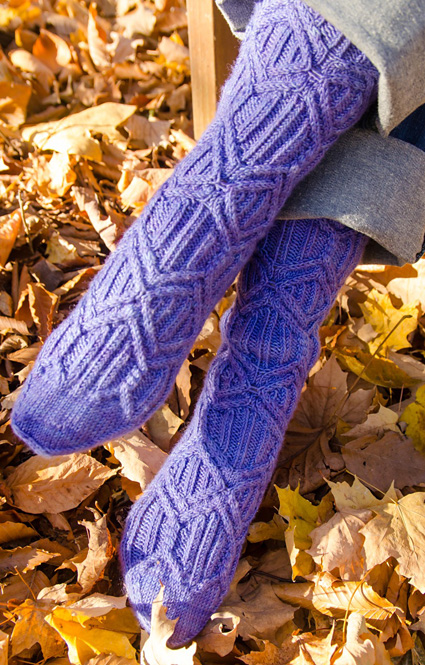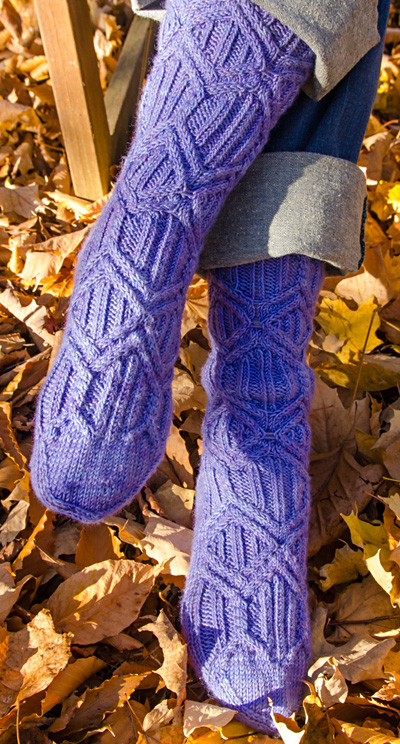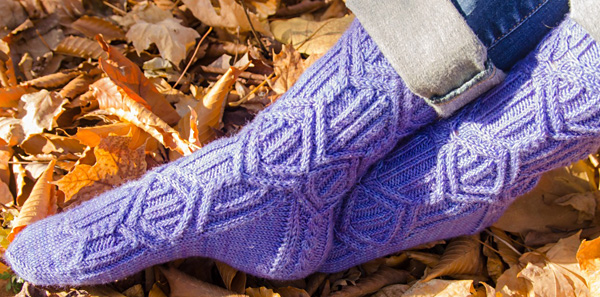

|
|
|

Back in the Dark Ages (1981), we physics students toiled to make simple circuits with relays, transistors, and even vacuum tubes. Technology has changed, but the science behind it hasn't. One of the most simple and elegant is Ohm's Law, which defines Current (I) as the ratio of Voltage (V) to Resistance (R), or I = V/R. This pattern started as an outline of cables on Stockinette: current (columns of twisted stitches inside the larger diamonds) flows from positive to negative potential; voltage drops as it passed through resistance (rope cables); magnetic fields form and rotate around flowing current. To promote wear resistance, the heel flap and heel turn are worked using a smaller needle. The pattern texture is very dense and thus stretchy. Be sure to use a stretchy yarn to maximize a comfortable fit. |
||
Tweet
 |
||
|
SIZE |
|
|
FINISHED MEASUREMENTS |
|
MATERIALS Notions |
|
GAUGE |
36 sts/48 rounds = 4 inches in Stockinette stitch, using larger needles |
|
PATTERN NOTES |
|
C4L: Slip 2 sts to cable needle and hold at front of work, k the next 2 sts, then k sts from cable needle Grafting: |
The charts for this pattern are very large and fit on a letter-sized page. Click here and print the resulting page. |
|
DIRECTIONS 
With larger needles, CO 64 sts. Distribute sts across needles as you prefer and join for working in the round. Cuff Round: Work Ribbing Chart around. Leg Setup: Work Setup Chart Round 1 around. 80 sts. Leg: Work Rows 1-37 of Main Pattern Chart once, then rows 2-37 once more. Heel Flap Heel Turn 
Change to larger needles. Setup Round: Sl 1, k 17 to end of heel sts; pick up and knit 1 st in each sl st along edge of Heel Flap plus 1 st between Heel Flap and instep, work across held instep sts in pattern as set, pick up and knit 1 st between instep and Heel Flap and 1 st in each sl st along edge of Heel Flap, k8. This puts you in the center of the heel flap, and is the new start of round.  Round 2: Work even in pattern as set. Repeat Rounds 1 and 2 until 72 sts rem, 40 on instep and 32 on sole. Foot Toe Repeat Rounds 1 and 2 until 32 sts rem, then work Round 1 only until 8 sts rem. |
|
FINISHING Tip: To avoid "ears" when grafting, at each of the four corners, lift the outside stitch over the second stitch in, sort of like a mini bind off, then graft the remaining stitches. Weave in at least 2 inches of tail ends on inside of sock, working a tight zig zag pattern across 2 rows of Reverse St st. |
| ABOUT THE DESIGNER |
|
|
|
Pattern & images © 2014 Nancy Vandivert. Contact Nancy |